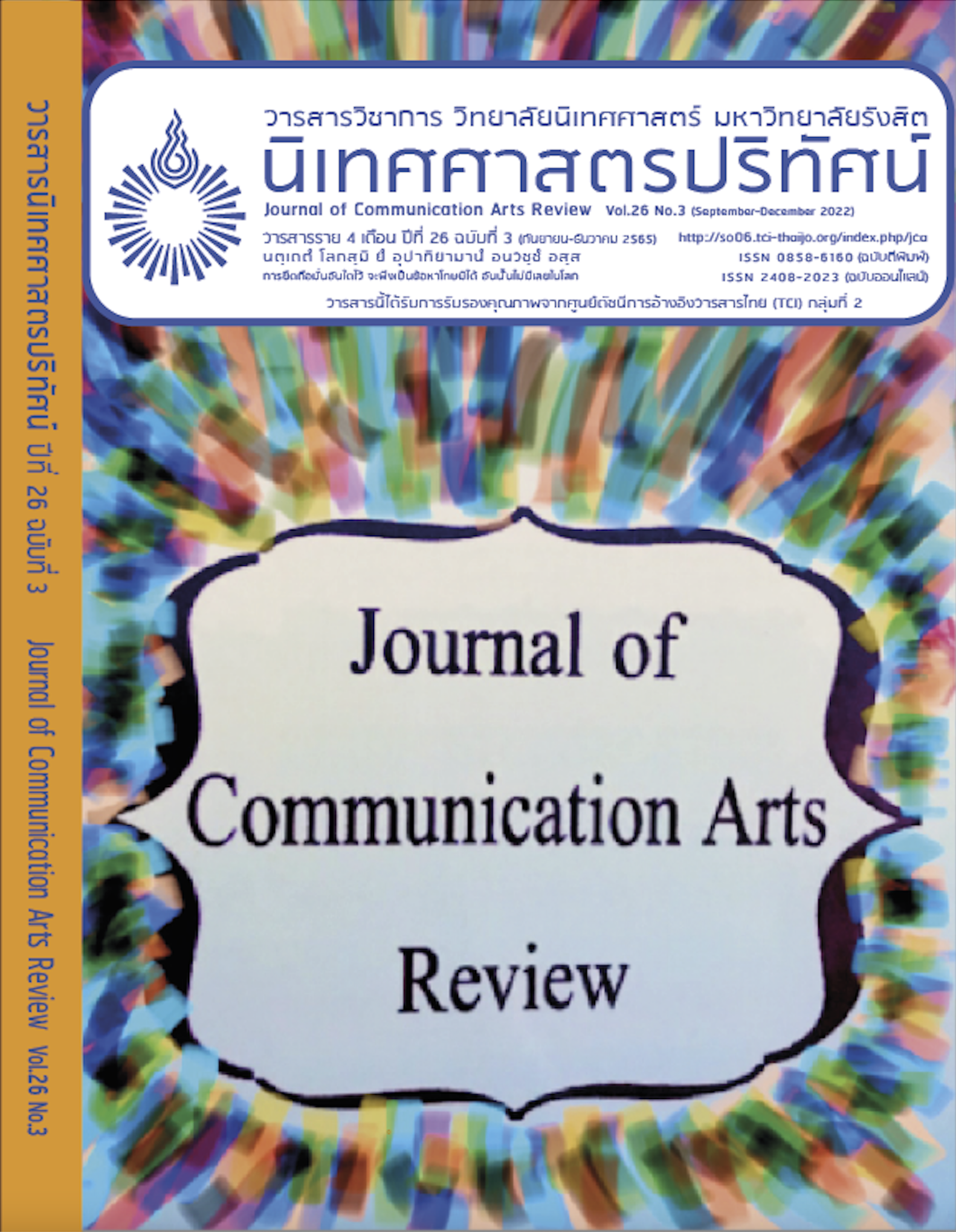The Sexualization of Females on Weibo and Its Interactive Influences on Chinese Young Females
คำสำคัญ:
Sexualization, Females, Weiboบทคัดย่อ
Discussion under the topic of sexualization is mainly focused on western society while nearly no academic exploration has extended the concept of sexualization into the Chinese context. Thus, this research aims to explore the sexualization of females in Chinese social media platform Weibo and its interactive (mutually reinforcing) effects on Chinese young females.
A qualitative approach was applied in this research, using content analysis to examine and interpret the photos posted by Chinese young females on Weibo in association with sexualization based on framing theory, and semi-structured interviews to gain an in-depth insight into the effects of sexualization on these young female Weibo users in the framework of cultivation theory and the concept of self-fulfilling prophecy, meanwhile understand their personal experience and feelings towards sexualization. The results indicated that sexualization among young females exists in Weibo, and the evaluation approach used to examine media sexualization in the western context can be applied in the Chinese context. Similar to that in the western countries, when presenting themselves through photos/images on Weibo, sexualization is commonly manifested in a variety of ways among the Chinese young female Weibo users, they mostly are exposed to and create self-presentation to somewhat less overt but sexually suggestive manners by cropping, editing, selecting certain scenes or angles, augmented by the outfits and poses to create the sexualized frames in the photos. In addition, it is found that the cumulative exposure to sexualized peer self-presentation on Weibo had cultivating and mutually reinforcing effects on these young Chinese females’ perception and behavior in terms of beauty standard, peer norms, self-concept (self-esteem, self-image, and self-evaluation), and desire to engage in self-sexualization, both strengthening and undermining their self-identity.
เอกสารอ้างอิง
Bigler, R. S., Tomasetto, C., & McKenney, S. (2019). Sexualization and youth: Concepts, theories, and models. International Journal of Behavioral Development, 1-11.
Coyne, S. M., Padilla-Walker, L. M., & Howard, E. (2013). Emerging in a digital world: A decade review of media use, effects, and gratifications in emerging adulthood. Emerging Adulthood, 1(2), 125–137.
Gill, R., (2012). Media, Empowerment and the ‘Sexualization of Culture’ Debates. Sex Roles 66, 736–745. Retrieved from https://link.springer.com/article/10.1007/s11199-011-0107-1
Hall, P. C., West, J. H. & McIntyre, E. (2012). Female Self-Sexualization in MySpace.com Personal Profile Photographs. Sexuality & Culture. doi:10.1007/s12119-011-9095-0
Hatton, E., & Trautner, M. E. (2011). Equal opportunity objectification? The sexualization of men and women on the cover of Rolling Stone. Sexuality and Culture, 15(3), 256–278.
Lamb, S., & Koven, J. (2019). The Sexualization of Girls: An Update. Culture Reframed. Retrieved from https://www.culturereframed.org/wp-content/uploads/2019/01/CultureReframed-SexualizationOfGirlsReport-2019.pdf
Li, Y., & Lin, L. (2015). Sexualization of Culture, Media, and Youth. Journal Of Chinese Youth Social Science. Retrieved from https://wenku.baidu.com/view/f06676bc86254b35eefdc8d376eeaeaad1f31684.html
Lai, L. T. (2020). Number of monthly active users (MAU) of the leading blogging apps in China as of October 2020 (in millions). Statista. Retrieved from https://www.statista.com/statistics/1154433/china-leading-microblogging-apps-monthly-active-users/
Merriam-Webster. (2018). What Is a “Thirst Trap”? The Merriam-Webster.Com Dictionary. Retrieved from https://www.merriam-webster.com/words-at-play/what-is-a-thirst-trap
Muralidharan, S. M., & Linjuan R., (2015). How Peer Communication and Engagement Motivations Influence Social Media Shopping Behavior: Evidence from China and the United States. Cyberpsychology, Behavior, and Social Networking, 18(10), 595–601.
Ng, S. V., (2016). Social Media and the Sexualization of Adolescent Girls. The American Journal of Psychiatry Residents’ Journal, 11(1). Retrieved from https://psychiatryonline.org/doi/pdf/10.1176/appi.ajp-rj.2016.111206
Nowatzki, J., & Morry, M. M. (2009). Women’s intentions regarding, and acceptance of, self-sexualizing behavior. Psychology of Women Quarterly, 33(1), 95–107.
Ramsey, L. R., & Horan, A. L., (2018). Picture this: Women's self-sexualization in photos on social media. Personality and Individual Differences, 133, 85-90.
Ruckel, L., & Hill, M. (2017). Look @ Me 2.0: Self-Sexualization in Facebook Photographs, Body Surveillance and Body Image. Sexuality & Culture, 21(1), 15–35.
Turner, A., (2015). Generation Z: Technology and Social Interest. The Journal of Individual Psychology, 71(2), 103-113. Retrieved from https://muse.jhu.edu/article/586631
Ward, L. M., (2016). Media and Sexualization: State of Empirical Research, 1995–2015. The Journal of Sex Research, 53 (4-5), 560-577. Retrieved from https://www.tandfonline.com/doi/abs/10.1080/00224499.2016.1142496
Xiao, L., Li, B., Zheng, L., & Wang, F. (2019). The Relationship Between Social Power and Sexual Objectification: Behavioral and ERP Data. Frontiers in Psychology. 10(57).
Zhang, L. & Pentina, I. (2012). Motivations and Usage Patterns of Weibo. Cyberpsychology, Behavior, and Social Networking, 15(6), 312–317.
ดาวน์โหลด
เผยแพร่แล้ว
ฉบับ
ประเภทบทความ
สัญญาอนุญาต
ลิขสิทธิ์ (c) 2022 วารสารนิเทศศาสตรปริทัศน์

อนุญาตภายใต้เงื่อนไข Creative Commons Attribution-NonCommercial-NoDerivatives 4.0 International License.


